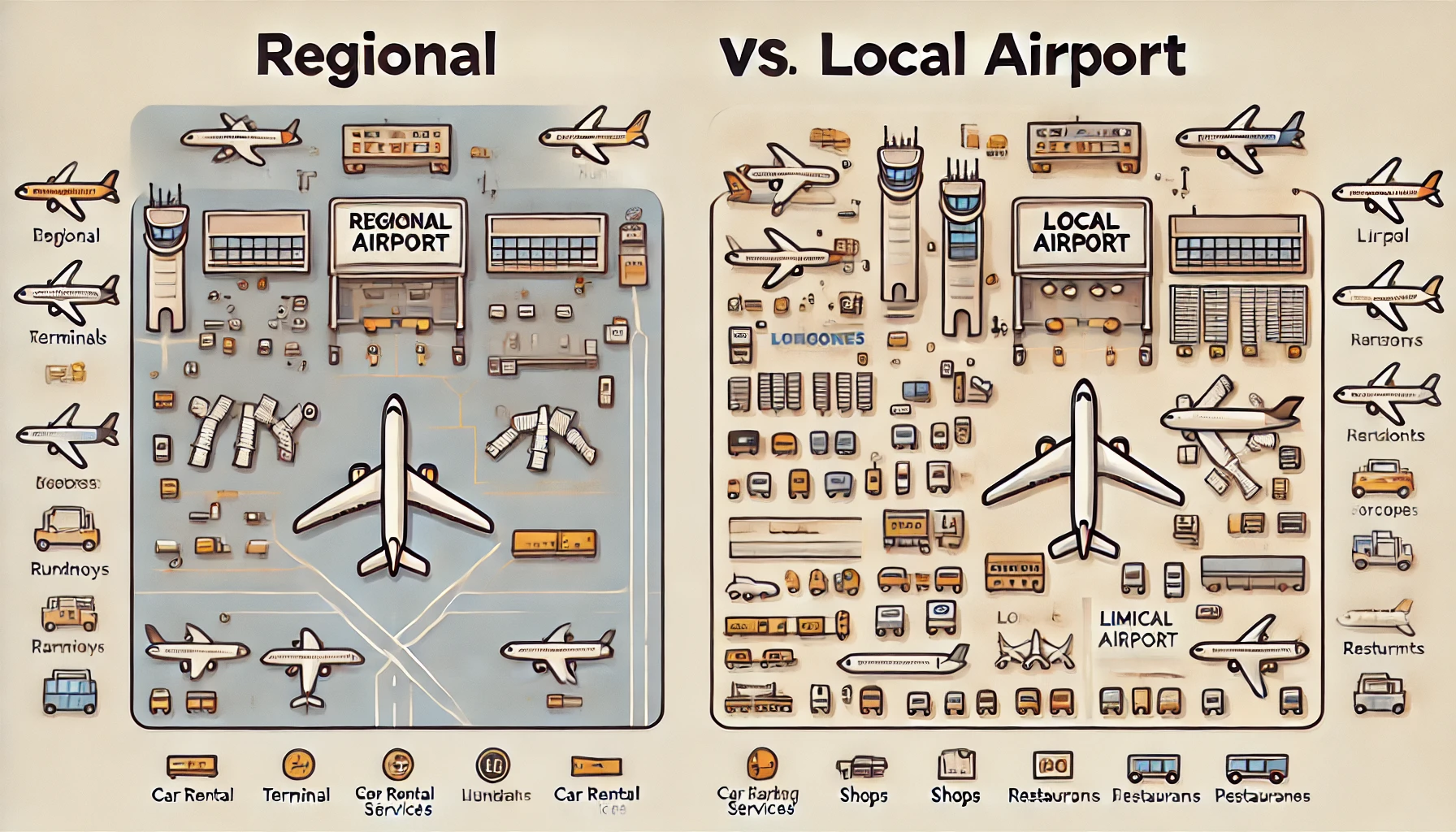When planning your next trip, you might come across terms like “regional airport” and “local airport.” While these terms are often used interchangeably, they refer to different types of airports that serve distinct purposes and cater to various travel needs. Understanding these differences can help you make better travel decisions and improve your overall flying experience. In this article, we will explore the key distinctions between regional and local airports, highlighting their unique features and roles in the aviation industry.
What is a Regional Airport?
Definition and Scope
Regional airports are designed to serve a larger area than local airports, often covering multiple cities or even an entire region. These airports typically handle a moderate volume of passenger traffic and offer a range of services and amenities.
Services and Amenities
Regional airports are equipped with more extensive facilities compared to local airports. They often have multiple runways, a variety of dining and shopping options, rental car services, and sometimes even business lounges. These airports also tend to support commercial flights, which means they can accommodate larger aircraft and offer more frequent flight schedules.
Connectivity and Destinations
One of the main advantages of regional airports is their connectivity. They usually offer direct flights to major hubs and other regional airports, providing passengers with convenient options for both domestic and international travel. This increased connectivity makes regional airports a popular choice for business travelers and those looking to avoid the hustle and bustle of major international airports.
What is a Local Airport?
Definition and Scope
Local airports, on the other hand, are smaller facilities that primarily serve a specific town or city. These airports are generally used for general aviation purposes, such as private and charter flights, flight training, and emergency services.
Services and Amenities
Local airports typically have limited facilities compared to regional airports. They may have a single runway, a small terminal building, and basic amenities like restrooms and parking. The focus at local airports is more on functionality and convenience for private pilots and local travelers rather than offering a wide range of services.
Connectivity and Destinations
Flights from local airports are often short-haul and cater to nearby destinations. These airports are ideal for quick trips, pilot training, and recreational flying. Due to their smaller size and limited commercial services, local airports provide a more relaxed and hassle-free experience for travelers.
Key Differences Between Regional and Local Airports
Understanding the differences between regional and local airports can help you decide which one best suits your travel needs. Here are some key distinctions:
- Size and Scope:
- Regional Airports: Larger, serving multiple cities or regions.
- Local Airports: Smaller, serving a specific town or city.
- Services and Amenities:
- Regional Airports: Offer extensive facilities, including dining, shopping, and rental car services.
- Local Airports: Provide basic amenities focused on general aviation needs.
- Flight Connectivity:
- Regional Airports: Connect to major hubs and offer more frequent flights.
- Local Airports: Cater to nearby destinations with short-haul flights.
- Types of Flights:
- Regional Airports: Accommodate commercial flights, larger aircraft, and higher passenger volumes.
- Local Airports: Primarily used for private, charter, and emergency flights.
Why Choose a Regional Airport?
Convenience and Accessibility
Regional airports offer a balance between the extensive services of major international airports and the convenience of smaller local airports. They are often located closer to urban areas, reducing travel time to and from the airport. Additionally, the smaller size of regional airports means shorter lines and quicker check-in and security procedures.
Cost-Effectiveness
Flying from a regional airport can also be more cost-effective. These airports tend to have lower fees compared to major international airports, which can translate to cheaper flight tickets. Moreover, parking and other ancillary services are often more affordable at regional airports.
Enhanced Travel Experience
The combination of better connectivity, fewer crowds, and comprehensive services makes regional airports an attractive option for many travelers. Whether you’re on a business trip or a family vacation, the streamlined processes and amenities at regional airports can enhance your overall travel experience.
Why Choose a Local Airport?
Personal and Charter Flights
Local airports are perfect for private pilots and those who prefer flying on charter flights. The smaller scale and personalized service at local airports make them ideal for a more intimate and flexible travel experience. Pilots appreciate the ease of access and the ability to quickly get in and out of the airport without the delays often experienced at more extensive facilities.
Community Support and Accessibility
Local airports play a crucial role in supporting the local community. They are often used for emergency medical services, firefighting, and law enforcement operations. Additionally, they provide valuable infrastructure for businesses and recreational aviation enthusiasts.
Lower Traffic and Stress-Free Travel
For those looking to avoid the hustle and bustle of larger airports, local airports offer a much more relaxed atmosphere. With fewer passengers and flights, the entire process from parking to boarding is typically quicker and less stressful.
Making the Right Choice
Choosing between a regional and local airport depends on your specific travel needs and preferences. Here are some factors to consider:
- Travel Distance: If you’re traveling a longer distance or need to connect to an international flight, a regional airport is likely your best bet.
- Flight Frequency: For more frequent and flexible flight options, regional airports offer more excellent connectivity.
- Travel Purpose: For private or recreational flying, or if you’re in need of emergency services, local airports provide the necessary infrastructure.
- Cost Considerations: Evaluate the cost differences in flight tickets, parking, and other services between regional and local airports.
Choosing the Right Airport for Your Needs
When planning your next trip, understanding the differences between regional and local airports can significantly impact your travel experience. Regional airports offer extensive services, greater connectivity, and a balance between convenience and accessibility. In contrast, local airports provide a more intimate and stress-free environment, ideal for private and charter flights. By evaluating your travel distance, flight frequency, purpose, and cost considerations, you can make an informed decision that best suits your needs. Whether you choose a regional or local airport, knowing what to expect can help you enjoy a smoother and more efficient journey.
Conclusion
In conclusion, both regional and local airports play vital roles in the aviation ecosystem, each offering unique advantages to travelers. Regional airports provide broader connectivity, extensive services, and a cost-effective travel option for longer distances and commercial flights. Local airports, on the other hand, cater to private pilots, charter flights, and community support services, offering a more relaxed and personalized travel experience. By understanding the differences between these two types of airports, you can better plan your travel and make the most of the facilities available to you. Safe travels!

